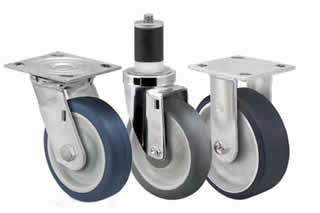
A caster is more than just a wheel; it’s a versatile rolling device that includes a wheel as a well as a mounting frame. As shown in the image to the left, casters contain a single wheel housed within a frame. They are frequently used on the bottom of chairs, workbenches and heavy machinery, allowing these items to roll smoothly across the floor. But there are different types of casters available, the most common of which are described below.
Plate Casters
The most common type, plate casters are characterized by a flat, square-shaped mounting surface. They usually have four holes — one on each corner of the mounting surface — which are used to secure the plate caster to the object. They are called “plate casters” because the mounting surface resembles as a square-squared plate.
Locking Casters
As the name suggests, locking casters feature a locking mechanism. Conventional casters are designed to roll and swivel freely. While perfectly fine for some applications, other applications require casters to remain locked in place. If a workbench with casters is placed on a sloped surface, for example, it may roll downhill unless the casters are locked. Locking casters offer the freedom to lock the wheels in place, thereby preventing the object on which they are mounted from rolling or swiveling.
Stem Casters
Stem casters also feature a wheel in a mounting frame, but they are unique because of the way in which they are mounted. While plate casters have flat, square-shaped mounting surface, stem casters feature a cylindrical-shaped rod for mounting. In the image displayed above, the caster in the middle is a stem caster. The cylindrical-shaped rod is placed inside an object’s mounting slot of the same shape and size. Some stem casters feature a threaded rod, whereas others feature plain round rods. Regardless, they all use rods for mounting.
Hollow Kingpin Casters
Hollow Kingpin casters are characterized by a stemless design with a hole on the top of the mounting surface. To mount a hollow Kingpin caster, the caster is positioned against the object, after which a fastener like a screw or bolt is driven through the hole and into the object.
Rigid Casters
Also known as fixed casters, rigid casters are characterized by their limited range of movement. Unlike other casters, rigid casters can’t swivel in a complete 360-degree range. Rather, they can only roll forwards and backwards. Rigid casters are usually stronger than conventional casters, but their limited range of movement makes them a poor choice for certain applications.
Monroe has a wide variety of casters that cover every application. If you need help deciding on what casters to use for your application reference our “Selecting Right Casters”
